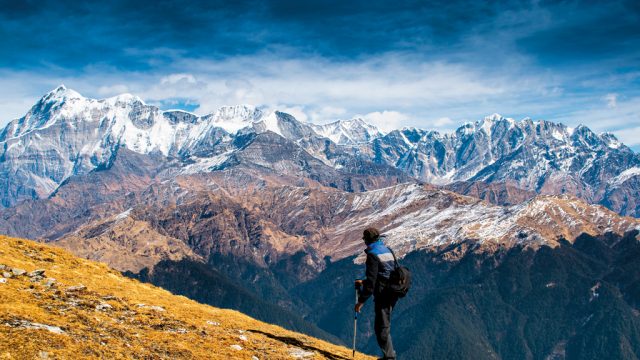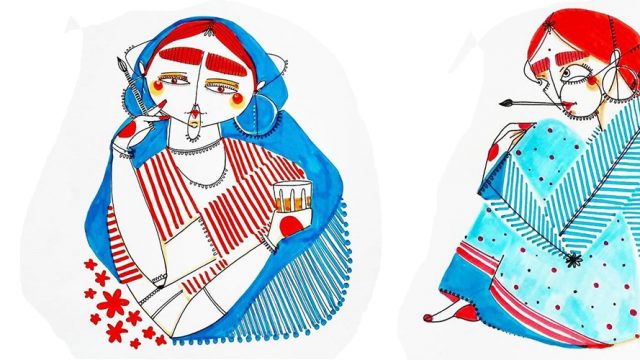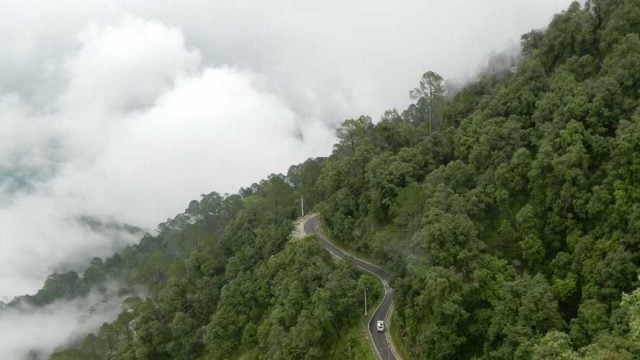In the quaint village of Pantwari in Garhwal region, Uttarakhand, over 1,000 people and dozens of mediapersons
as part of a unique ‘Bakri Ka Swayamwar’.”
There is very little about the abovementioned text that does not sound crazy. Except that, on the morning of February 25, 2017, several newspapers published similar reports. The event was organised by Green People, a socio-commercial organisation,
which also runs farmstays called the Goat Village (TGV) in Uttarakhand. Naturally, I am beset with curiosity: Why a swayamwar of goats? And exactly what does a homestay have to do with goats? Puneet packed his camera and lenses, I restocked my pens and we were off to Garhwal to find some answers.

After we crossed Mussoorie, roads became emptier, towns smaller and the Uttarakhand hills—some arid and low-lying, others lush and towering—more dominating. Soon, we reached tiny Pantwari and then even tinier Laser Gaon, from where the famous trek to Nag Tibba begins. The Goat Village we were headed to happened to be halfway up this trek route.
On the last leg of our journey, Puneet and I were in for a treat. First, Vinod and Suraj from the Village came down with hot mint tea. Second, delays on the road had converted our arrival into a nighttime trek. Except for the light from our solar lanterns, we were enveloped by darkness all throughout the 2.3km walk. Whenever we stopped to take a break, we turned them off and enjoyed the effect—of floating blind in an endless, soundless star-studded universe. Then we arrived at a faintly illuminated cottage.
It turned out to be TGV’s greenhouse-cum-sitting area dubbed ‘cafeteria’. It was filled with tables and chairs, colourful mattresses, a shelf with vintage paraphernalia and dim candles. The homestay does not have electricity. We sat here with Mani Mahesh, volunteer guest manager, who wore a shawl and spoke in a near-whisper so as not to disturb the silence. He introduced the place to us: “I wouldn’t call it a homestay. We are actually trying to recreate villages in abandoned lands and promote a smart minimalistic lifestyle.” Priyanka, employed here as a village representative, offered us warm towels and hot ginger water soon after. Later, as Mani handed us the ‘bakri girl and bakri boy comfort kit’, which was a sack bag that held a thermos, raincoat, solar lantern and umbrella, he told us that there was no room service since a very small group manages the whole place. And yet, the staff made our beds and provided us with tea in the morning and hot water bottles at night.
We retired to our room by 9.30pm, exhausted from the trek and a day of travel. The pleasant-faced Suraj, working here as a farm butler, saw us to our cottage. It was warm inside. The king-sized bed was comfortable. The window bed had a view of the night sky. I chose the former, Puneet the latter, and soon enough, the sandman had paid us a visit.

Morning was a smorgasbord of activities—I stepped out just a little after sunrise to meet a fresh, clear day. All cottages are coloured mustard on the inside, and have dark mud brick façades. They are built using the Koti Banal technique—traditional architecture that uses easily available material to create earthquake-resistant houses. They are well insulated from the cold, spacious and equipped with all basic amenities and a fine bathroom. All cottages have wooden pillars, ochre-coloured doors and corncobs hung outside to dry. Each has a verandah with chairs. I walked a bit along the stone path and saw Mani practising yoga in front of his cottage, bathed in sunlight. A little ahead, three people were busy watering and sowing a patch of tilled land. “We are growing Chinese cabbage. It’s a premium vegetable,” said Birender Pawar aka Pawarji, farm supervisor and proud Garhwali. A little ahead was the cafeteria, outside which country chicken grazed excitedly, surrounded by the two-month-old puppies Rimjhim and Jhilmil. I saw a lone rooster too. “But what about the goats?” “Oh, they are down at Pantwari because it’s too cold these days. They’ll be up next month,” Mani told us. But to our surprise, nine of them were brought up a little sooner than usual the very next day.

And in just one brief morning walk, I got a fair idea how this place functions. People are involved in caring for animals, agriculture, cooking and maintaining the place and its surroundings. Seeing them work hard, most guests wish to contribute too. The more inspired stay on to volunteer for weeks. “And who are the Green People?” I asked Mani, as we sipped lemongrass tea in the cafeteria, where, now that it was morning, I noticed the presence of a vegetable patch right in the centre. To answer that, he connected me to the founder, Rupesh Kumar Rai, who told me how he had something of an epiphany after being stuck in Rudraprayag during the 2013 Uttarakhand floods and witnessing the destruction of nature and livelihoods. Previously associated with a big hospitality brand, he decided to work for a cause and start the organisation, with reverse migration as the ultimate goal.
Mani too calls himself a reverse migrant—someone who left the city behind. He told us how most villagers are abandoning their homes for cities because they are not able to make a good living here. The Green People have set up Goat Villages to promote agro, eco and responsible tourism, create jobs and promote their brand, Bakri Chaap, which connects farmers directly to the consumer. “Hopefully, this will stop migration and even help reverse migration,” said Mani.
At TGV, the goat is the mascot. After all, the animal is considered the spirit of the Himalaya, sustaining thousands of livelihoods. Mani continued, “And yet, it is not producing enough milk. Its gene pool has been severely damaged. And that’s why we had the Goat Swayamwar, to spread awareness about proper breeding practices.”
For the rest of our time here, Puneet and I took on a variety of roles. A young journalism student was volunteering for a few weeks. Once, I helped her count chickens at the chick pen, titled ‘chik-inn’. “4…5…6…7…8…9…where are the others?” she said, alarmed. Thankfully, Kamal, another farm butler employed here, brought them in at just that moment.
One morning, I joined Pawarji for some organic farming. We marched to the cultivable plot just below the kitchen, armed with pumpkin, bottle gourd and ridge gourd seeds. Pawarji dug with a shovel and I picked up a handful of manure and spread it evenly across the patch. He hummed a Sanskrit verse that commemorated the sowing season, and I sowed the seed. It was overcast, so the hills would go from spring glow to winter mist in a matter of seconds.
Another day, Puneet and I were trekkers—or at least Puneet was. A ligament tear prevented me from visiting Nag Tibba. That evening he told me all about the experience.
The peak is a 4km moderate trek from the Goat Village. You first reach the base camp, which is a meadow used by campers. At Tibba, there’s a Nag Devta Mandir (serpent king’s temple), but it is the surrounding view, said Puneet, which is breathtaking. From here, a steep trek takes you to Nag Tibba’s peak or jhandi, which was still snow-covered in early March.
While all this took place, I was nursing my injury. But that allowed me to take on another role—solo traveller. On an afternoon of silence, I had mainly myself for company. I hobbled around the place, thinking about the hills and skies and existence. “So many people just like to be by themselves and relax here,” said Mani. The Goat Village does have a calming effect.

The food served at TGV is naturally grown (mostly on the campus itself); it’s delicious and cooked using local recipes. A hill surrounds the Village, from the top of which you can enjoy views of the snow-covered Bandarpunch range. Here, we enjoyed our sunny-side-ups made of country eggs. The buransh (rhododendron) juice was refreshing. On a walk around the campus, we spotted many of them blooming on their trees. Mani picked a few for us, which we ate raw. They tasted quite good—sweet around the centre and sour at the petals. Chamomile flowers and goji berries are some of the other plants that grow here in the wild.
At our first meal, we thoroughly enjoyed the red Himalayan rice soup, makki ki roti and yellow lentil curry. The next night, our dinner was at one of the farmers’ homes. It was cooked on a chullah in a traditional low-roofed hut. We glistened in the orange emitted by the light of the stove.
On two occasions, we ate fabulous kidney beans—one being the famous Harshil rajma and the other Garhwal’s red rajma. Both were brilliant with rotis made of jhangora (banyard millet) and mandua (finger millet). The dessert was great too—I particularly enjoyed the jhangore ki kheer (banyard millet rice pudding).

On our last day, a large number of people checked into the Goat Village. Suddenly, the almost soundless haven began bustling with activity.
Mani arranged for a Garhwali trio to put up an energetic display of folk beats. A makeshift ‘Lallan Chai Bhandar’ (Lallan’s tea stall), another of the Green People’s initiatives, was arranged for. The place serves old-fashioned goodies such as chana jor garam (roasted chickpeas) along with hot tea. At night, a mild bonfire was set up.
But, far from the madding crowd, Puneet, the volunteer and I just chose to relax in the cafeteria. Soon, Mani joined us too. We spoke about stars, and how their light travels millions of years before hitting us. We then spoke about the Goat Village and what the place meant to us. For Mani, it was about bringing about change. For me, it was a place for introspection. For the volunteer, a sense of escapism. And for Puneet, it was the uniqueness
of the experience. In this manner, all of us, in our own little ways, made this place our own.

The information
Getting There
Dehradun has the nearest airport, with direct flights from Delhi (multiple options, from approx. ₹2,500 one way), Lucknow (Indigo, from approx. ₹2,500) and Mumbai (Jet Airways, from approx. ₹5,000).
Several buses ply between Delhi and Dehradun. The Dehradun Shatabdi takes 6hrs from New Delhi (from ₹655). From Dehradun,
it’s a 130km/4hr drive. Ask the Goat Village to arrange a shared taxi (₹450 per head) or a private taxi (approx. ₹3,000 per vehicle) to Laser Gaon, via Pantwari. From here, a 2.3km very beautiful and moderate trek to the Goat Village begins. As the elevation
increases, the vistas change.
The Goat Village
Pay What You Like (PWYL): This place allows guests visiting in smaller groups, such as couples, to pay whatever room tariff they deem suitable, irrespective of the fixed rates. This is only valid during
weekdays and non-holidays, the maximum stay duration for this is two nights and eligibility also depends on vacancy and a screening process.
The Village has four standard cottages (₹7,000 doubles, taxes included), four deluxe cottages (₹10,000 doubles) and two condominiums
(one accommodates up to 9 persons, the other 6; ₹2,000 per person). The tariffs include all meals, hot water, tea/coffee, escorted trek to Nag Tibba and bird walks.
Contact
91-7252007597, [email protected]. For details, visit thegoatvillage.com. The place advises you to carry your own towels, soaps, and other toiletries to prevent wastage. Charging ports are available in the kitchen, where they run on solar panels. The trek isn’t easy, and you should carry a water bottle and take breaks.

What to See & Do
>The Goat Village has a ‘keechad’ pool (mud pool), where you can participate in a ‘keechad party’.
>If you’re visiting between July and September, it’s possible to go mushroom and herb hunting. Accompany
one of the staffers and then eat food cooked using them.
>If the weather permits, kite flying
can be enjoyed.
>For the bird and insect enthusiasts,
it’s possible to take a walk in the areas surrounding the Goat Village and spot beautiful avifauna. One path goes over the hill, another through a semi-forested area. You can also pick rhododendron, chamomile, goji berries on the way and generally enjoy the views.
>Speak to local Garhwali folk. They have a lot of stories to tell. The staff at TGV is an interesting
bunch too—Pawarji claims to have once fought off a bear!
>The trek to Nag Tibba takes the good part of a day, so leave as early as 7am.
hills
Himalaya
India





